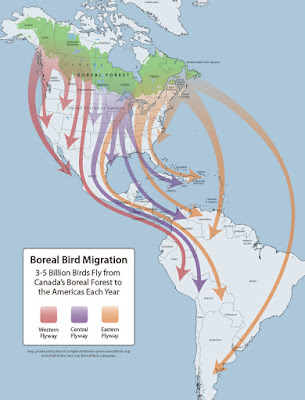Joey (in Chicago):
Interesting question that you pose given a recent report from Ryan Brady, an ornithologist/bird researcher/scientist for the Wisconsin DNR. See his list of 20 wood-warbler species that he detected on 8/29/17 near Bayfield/Washburn, WI (near Lake Superior): (Then see more of my commentary, below.)
From: Ryan Brady <ryanbrady10@hotmail.com>
Subject: [wisb] 20 warbler sp. - Bayfield County
Date: Wed, 30 Aug 2017 01:50:37 +0000
An excellent flight last night brought 20 species of warblers to the trails around my property this morning, including Golden-winged, Blackpolls, Bay-breasteds, Mournings, Palms, Pine, and more. Thrushes were on the move in the morning fog, yielding some Swainson's and my first Gray-cheekeds of the fall. Also had my first Lincoln's Sparrow and a nice push of 3 Yellow-bellied Flycatchers.
Full eBird checklist at http://ebird.org/ebird/wi/view/checklist/S38887593
Ryan Brady
Washburn, Bayfield County, WI
http://www.pbase.com/rbrady
*
Responding more to your questions, above:
Dispersal begins earlier than migration. Fledgings leave the nest and begin their independent lives while foraging BEFORE eventually migrating. So newborns may linger in an area near where they were born. By mid- to late-August at upper Midwest latitudes, some begin to migrate south while other species -- such as American Redstart, Palm Warbler, Yellow-rumped Warbler, among others — may have a protracted migration. These three species are among the latest to leave northern latitudes, with some Yellow-rumped and Palm remaining through November and December -- and, in recent years, some of both species persisting through Christmas Bird Count surveys in the upper Midwest (and even remaining throughout the winter in some cases). Pine Warbler may also persist late while sometimes feeding at seed feeders after an insect fauna is depleted with freezing temperatures.
A nice resource to read about breeding vs. non-breeding ground ranges of wood-warblers is in Warblers (the field guide from 1998 by Jon Dunn & Kimball Garrett). Its information is dated in spots, but most of the text remains valid. As a more updated complement, I also refer to the fantastic The Warbler Guide (Tom Stephenson & Scott Whittle, Princeton University Press, 2013). This guide's range maps for migration and breeding/non-breeding ranges more accurate in some cases than Warblers, with more comprehensive photos for each species. You won't be sorry for purchasing both books.
Enjoy the migration, everyone....and time for my raptor class at Merritt College to begin next week (BIOL 80A, Raptors Of The San Francisco Bay Area....via danielsmerrittclasses.blogspot.com)
Regards, Daniel
warblerwatch.com (hosts my "Birding Tours" information)
Got wood-warbler questions? If so, I have answers for you. I'm Daniel Edelstein — biologist, birding guide, birding instructor (www.warblerwatch.com and danieledelstein@att.net) — who ponders: Are there any wonders in our world more fascinating than the elegant beauty of wood-warblers? (All photos © Martin Meyers unless otherwise noted.) By the way, my upcoming new adult college birding class is featured at: http://danielsmerrittclasses.blogspot.com/
Subscribe to:
Post Comments (Atom)

No comments:
Post a Comment